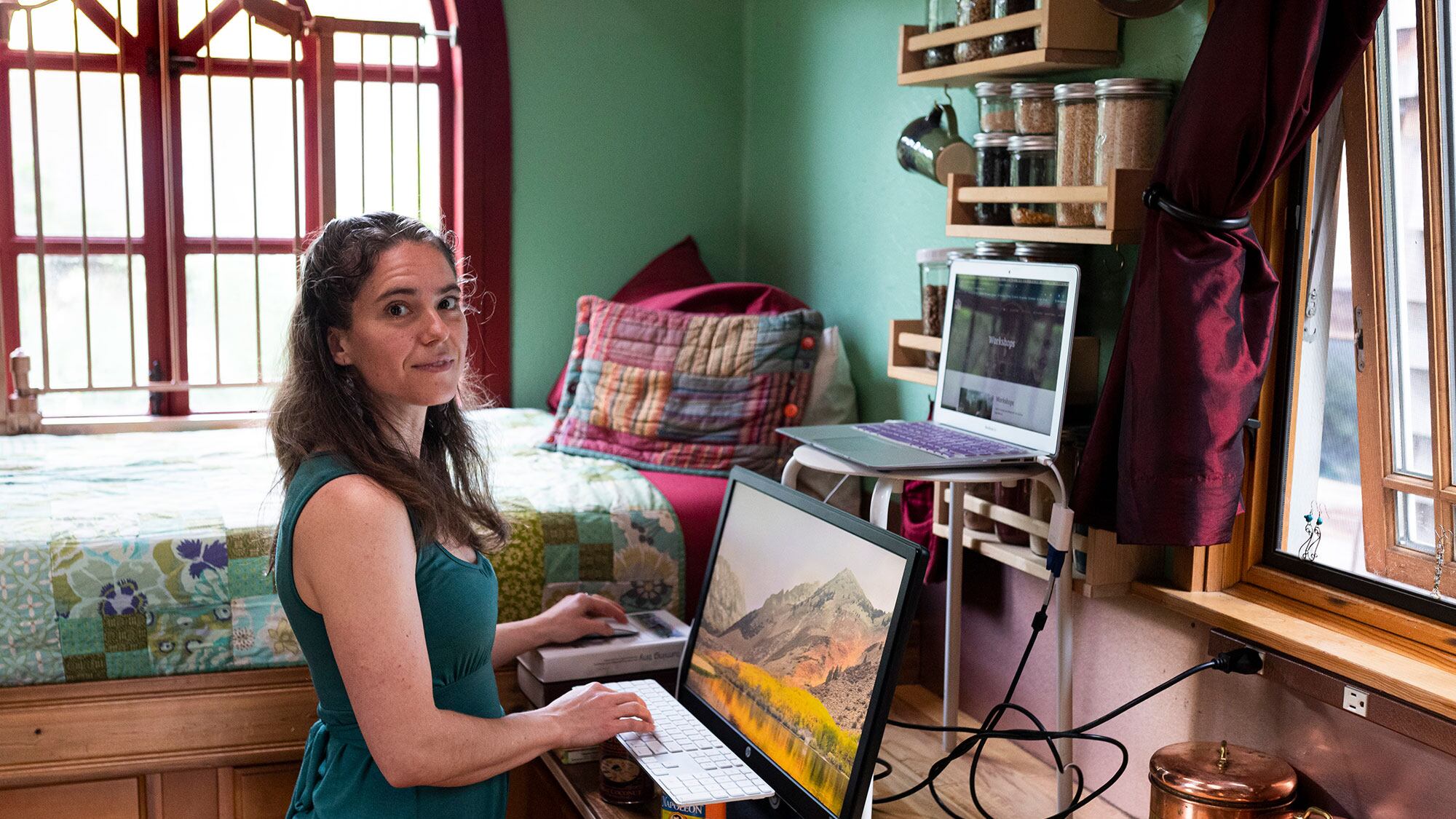Seven months ago, living in a tiny home made perfect sense to Maria Menzel and Tino Meyer.
The couple had come to Portland from Germany in 2019 on five-year work visas after Meyer accepted a job in the engineering department at Adidas. Investing in anything more expensive didn't seem reasonable given that they'd be in the United States only temporarily—and anyway, the idea of minimalist living appealed to their sensibilities.
"Most of all, I think we just love the concept of downsizing," says Menzel, 33. "Knowing that tiny houses are so popular in Portland, we were fascinated by the concept and thought this would be the right time just to try this."
That was in November, a time of open restaurants, bustling bars, unrestricted hiking trails, and plenty of other reasons not to stay cooped up at home. But ever since the outside world was effectively rendered off limits, the pair has spent most of their time together between the walls of their 208-square-foot mobile house, currently stationed in a backyard in the Cully neighborhood, rationing out work time at the single table that can fit inside.
So far, their relationship has not sustained any significant damage. But Menzel, who's studying for a master's degree in sociology through online courses from the University of Hagen while her husband telecommutes to his job at the sportswear giant, confesses the situation has made the typical challenges of cohabitation more intense.
"Whenever one of us is moody, which is totally normal, you have to share it," Menzel says. "You are sharing everything every single minute of the day."
Over the past two and a half months, people everywhere have been forced to confront the limitations of their living situations. But not many are doing it while confined to a space not much bigger than the average dorm room.
In Portland, the scenario is slightly more common: The city is a hub for tiny homes, exceptionally small dwellings that often resemble glammed-up tool sheds on wheels. While they exist in a legal gray area due to hazy zoning laws, their relative affordability—most cost between $30,000 and $100,000—and small environmental footprint have made them popular in a town that is both famously eco-conscious and growing increasingly congested. An estimated 300 of them are scattered around Portland, according to Kol Peterson, a small-living advocate.
For many, though, the main appeal of the tiny home is that it forces a scaled-down lifestyle, which in turn encourages greater communion with the world beyond your doorstep. But what happens when "Stay Home, Save Lives" becomes the mantra, and your whole world is suddenly reduced to the size of a walk-in closet?

Lina Menard, for one, admits it's not exactly what she signed up for.
She's lived in tiny homes for nine years—she even designed her current one herself. Calling hers "tiny," though, might be an understatement. It's 100 square feet, making it "one of the tinier tiny houses out there," she says. Despite its size, visitors often refer to the house as a "cathedral" because of its large windows.
Menard has moved her home eight times. At the moment, she's in a backyard in Irvington. She's a true believer in the form: Her company, Niche Consulting, is devoted to placing people in alternative living situations. But she confesses the era of self-isolation has, to a degree, changed the relationship to her own home, at least temporarily.
"Part of my interest in living small is to live bigger outside of the house," she says. "I really enjoy having a little home of my own, and then the whole rest of the world to go hike and to happy hour and everything else. So it is a change for sure to be in my house or in my yard as much as I am."
The main issue, she says, is not being able to do two things at once. When her bed is folded down, there's no room for the makeshift standing desk she works at during the day, or anything else, really. When it's time to sleep, she has to essentially pack up the rest of the house, no matter how tired she might be. She also has to be more strategic about shopping for groceries, given that she only has a mini-fridge for food storage—a particular challenge right now, when trips to the market represent a safety hazard.
It's frustrating at times, she admits. But being forced into a routine, she says, has its own psychological benefits. Menzel agrees: Although their house has more defined spaces, with a kitchen, living room and loft, with both her and her husband working from home, finding ways to both share space and stay out of each other's way is key. She spends the morning studying in the living room while he takes calls from the desk in the kitchen; in the afternoon, they rotate. They also make sure to get outside twice a day, usually for a run or bike ride, no matter the weather.
"It's not too much of a burden for us," Menzel says, "but you have to organize yourself."
Neither she nor Menard regret their choice to live small—but for them, it was a choice. Others have been pushed into it.
A month ago, 26-year-old Kharia Epps was staying at a battered women's shelter in Vancouver, Wash., with her 1-year-old son. When the pandemic forced the facility to shut down, she had only 48 hours to find somewhere to go. After some frantic searching, she came across Caravan, the tiny house hotel on Northeast Alberta Street. Kol Peterson and his wife, Deb Delman, established the complex in 2013 to allow prospective tiny home dwellers to "kick the tires on the experience." But with the regular hotel business paralyzed by COVID-19, they opened the six units as weekly and monthly rentals for frontline workers and others in need of a place to stay, at deeply discounted rates.
Epps is now paying $1,200 for a 170-square-foot wood-paneled cabin. At first, she thought it would be a long adjustment period. But after three weeks, she says it feels not much different than a studio apartment. When her son is crying, there's no escaping, and she wishes he had more room to play and learn to walk in. She also misses having laundry. But the trade-off is the other amenities, which include a canopy-covered fire pit for nightly bonfires with the other tenants.
"I feel like after being here three weeks, I could live here long term," she says, "if that was ever an option."
Peterson believes it's a conclusion more people will come to once the health crisis ends and the financial crisis begins. With a recession on the horizon, the idea of downsizing and minimal living is going to look more appealing, he says. In the long run, he sees the pandemic being a boon for the tiny house movement.
"This only gives extra credence to the idea of reducing month-to-month housing expenses," he says.
And for the already converted, the pandemic has validated why they chose to live this way in the first place.
"On the one hand, this little space needs to be my everything all day long now," Menard says. "And on the other hand, that's exactly what it was for."

